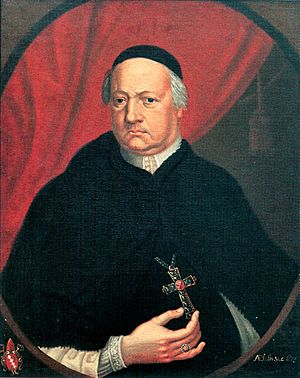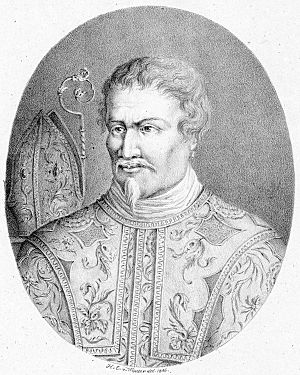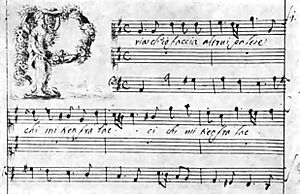Agostino Steffani facts for kids
Agostino Steffani (born July 25, 1654 – died February 12, 1728) was an amazing Italian person who did many things! He was a bishop (a high-ranking church official), a polymath (someone who knows a lot about many different subjects), a diplomat (someone who represents their country in talks with other countries), and a composer (someone who writes music).
Early Life and Learning
Agostino Steffani was born in a town called Castelfranco Veneto in Italy. When he was a young boy, he joined the choir at San Marco in Venice. He was a very good singer and was often asked to sing at important events.
When he was only 11 or 12 years old, he was already singing in operas in Venice! At 13, a powerful leader named Ferdinand Maria, the Elector of Bavaria, took him under his wing. An Elector was a ruler of a state in Germany. Steffani moved to Munich and his education was paid for by the Elector. He was even given a good salary.
Steffani learned from a musician named Johann Kaspar Kerll. Later, in 1673, he went to Rome to study with Ercole Bernabei. While there, he wrote six special songs called motets. You can still find the original copies of these songs in a museum in Cambridge, England.
When he returned to Munich in 1674, Steffani published his first music book. In 1675, he became the court organist, playing music for the royal family.
Working for Royalty
We don't know exactly when Steffani became a priest. He was given the title of "abbot of Lepsing." Even though he was a priest, he also wrote music for the stage, especially operas. His operas were very important and influenced other composers at the time.
His first opera, Marco Aurelio, was performed in Munich in 1681. Other operas he wrote include Solone (1685), Servio Tullio (1686), and Niobe, regina di Tebe (1688).
Even though the Elector Maximilian Emanuel liked him, Steffani took a new job in 1688. He became the Kapellmeister (music director) at the court of Hanover. A Kapellmeister was in charge of all the music at the royal court.
In Hanover, he became good friends with Ernest Augustus, who later became the Elector of Hanover. He also met important people like the Elector's daughter Sophia Charlotte (who became a Queen), the famous thinker Leibniz, and many writers. In 1710, Steffani was very kind to a young composer named Handel, who was just starting his career.
Steffani had many successes in Hanover. He wrote a long list of operas for the new opera house, starting with Henrico Leone in 1689. Other operas included La Superbia d'Alessandro (1690) and Orlando generoso (1691). Many of his opera stories were written by a friend named Abbot Mauro.
Many of Steffani's original music scores are kept at Buckingham Palace in England. They were brought there by the Elector of Hanover in 1714 when he became King George I of Great Britain. But Steffani wasn't just a musician in his new home.
A Life in Diplomacy
When Ernest Augustus became an Elector in 1692, there were some problems that needed solving. Steffani was chosen to travel to different German courts as an envoy extraordinary (a special representative) in 1696. He was very good at diplomacy, which is the art of dealing with people in a sensitive and effective way.
Because of his success in helping Catholics in Hanover, Pope Innocent XI made him a bishop in 1696. He became the bishop of Spiga, a place in modern-day Turkey. Between 1709 and 1723, Steffani also served as a Vicar Apostolic for a new Catholic area in Germany. A Vicar Apostolic is a bishop who leads a church area that is not yet a full diocese.
In 1698, he was sent as an ambassador to Brussels. After Ernest Augustus died, Steffani started working for another ruler, John William, in Düsseldorf. There, he held important positions like privy councillor (a close advisor to the ruler) and protonotary of the Holy See (a high-ranking official in the Catholic Church).
To avoid any problems with his new important roles, Steffani started releasing his new operas under the name of his secretary, Gregorio Piva. This way, people wouldn't think a high-ranking church official was spending all his time writing operas!
Steffani did not go to England with Elector George. However, in 1724, a music group in London called the Academy of Vocal Music made him their honorary president for life. In return, he sent them a Stabat Mater (a type of religious song) and three madrigals (songs for several voices). These pieces were very advanced for their time.
Steffani's operas were also special because they understood what the stage needed. This was important at a time when operas were becoming more like formal concerts. Without the old music books at Buckingham Palace, we might not know about these operas today.
Steffani is also famous for his chamber duets. These were like short songs for two voices, with a simple musical accompaniment called a figured bass. The British Library has more than a hundred of these songs!
Steffani visited Italy one last time in 1727. There, he met Handel again, who always remembered Steffani's kindness from their time in Hanover. This was the last time the two composers saw each other. Steffani returned to Hanover and sadly passed away on February 12, 1728, while on a diplomatic trip in Frankfurt.
His Music
Steffani's music was different from other Italian composers of his time, like Alessandro Scarlatti. He was very good at writing music for instruments. His pieces, including the introductions to his operas, combined the smooth style of Italian music with the clear and organized style of French music.
Works
- List of compositions by Agostino Steffani
See also
 In Spanish: Agostino Steffani para niños
In Spanish: Agostino Steffani para niños




